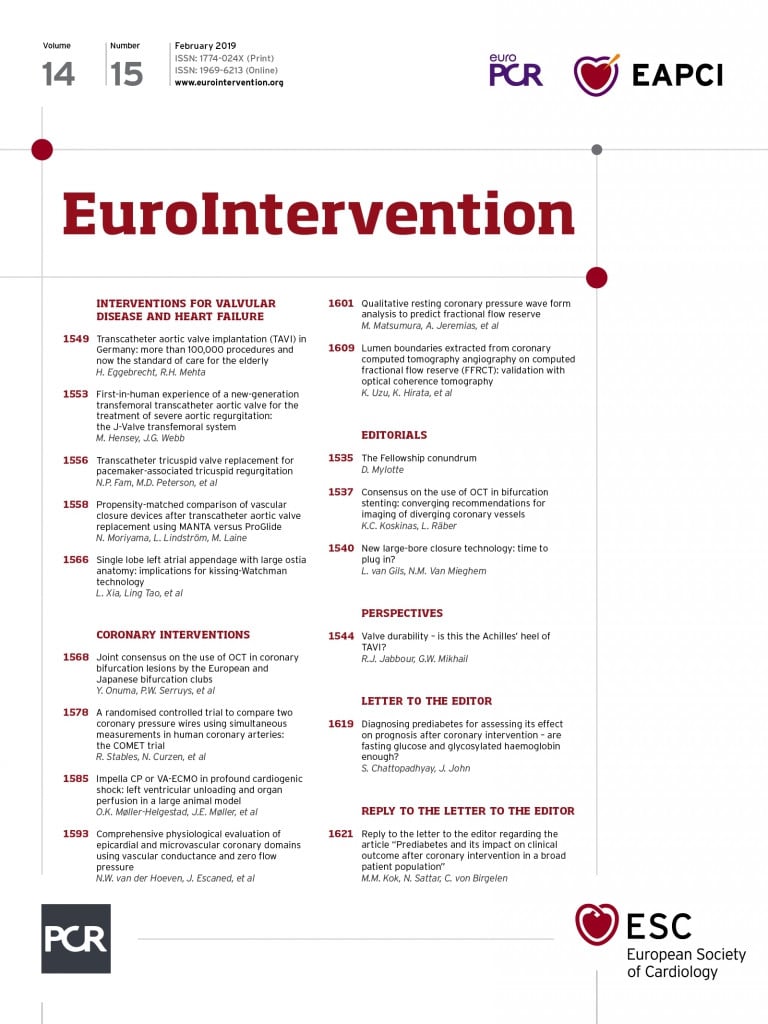
Introduction
Transcatheter aortic valve implantation (TAVI) has revolutionised the treatment of severe aortic stenosis and is now the default option for patients with elevated surgical risk. Since the first valve implantation in 2002, there have been dramatic improvements in both technical/procedural aspects and equipment used which have naturally led to improved outcomes1,2. The procedure has evolved and become streamlined with “minimal” TAVI performed in many centres. Preprocedural computed tomography (CT) sizing, procedural use of conscious sedation, lower profile sheaths and improvements in vascular closure devices have led to mortality and morbidity reductions and earlier discharge times (often within 48 hours)3. Due to the results of randomised trials, guidelines have shifted to include intermediate-risk patients. Numerous trials of low-risk patients are ongoing, and registry data so far have been encouraging4-7. As we look to the final frontier of TAVI in younger lower-risk patients with inevitably longer life expectancies, valve durability remains a concern and is likely to become a central focus.
CONSENSUS DEFINITIONS TO ATTAIN CONSISTENCY
Due to the inconsistent definitions used in previous studies and the fundamental need to compare accurately TAVI with surgical aortic valve replacement (SAVR) durability in future studies, several recent guidelines have sought to standardise definitions of valve dysfunction, deterioration and valve failure8-10. A recent European consensus guideline has, importantly, made the distinction between bioprosthetic valve dysfunction (caused by structural or non-structural valve deterioration, thrombosis or endocarditis) and the new patient-orientated clinical endpoint of bioprosthetic valve failure (BVF), which also includes the clinically important manifestations of valve dysfunction (valve intervention/valve-related death)8. Distinguishing clearly between dysfunction and failure in trials is important since identifying potentially clinically relevant valve dysfunction earlier in the disease process could lead to new therapies that may lower the risk of serious structural deteriorations occurring.
BIOPROSTHETIC VALVE DYSFUNCTION ASSESSMENT
Echocardiography is the prime modality for the assessment of structural valve deterioration (SVD), and is the most practical way of determining serial changes in transvalvular gradients. Echocardiographic assessments should ideally be performed prior to discharge or within 30 days of the index procedure, at one year, and then annually8. Transoesophageal imaging, including three-dimensional (3D) echocardiography, can improve resolution when assessing valve morphology. Whilst echocardiography is superior for assessing valve haemodynamics, multi-detector computed tomography (MDCT) provides better anatomical/structural detail. For example, MDCT may be more sensitive than echocardiography in detecting valve thrombosis, especially subclinical leaflet thrombosis in which haemodynamic consequences have yet to develop. Hypoattenuated leaflet thickening (which indicates thrombus), stent frame expansion, eccentricity index, and calcification are all easily obtained parameters8. Since MDCT is unable to provide data on aortic valve gradients, it is therefore of limited value in assessing SVD, but nevertheless is an important complementary imaging modality for assessing numerous transcatheter heart valve (THV) complications.
TAVI-SPECIFIC FEATURES AFFECTING DURABILITY
Whilst there are similarities between valve leaflet tissue and the anti-calcifying processes used in most THVs and surgical bioprostheses today, there are distinctive TAVI-specific procedural and equipment factors that could theoretically limit longevity. These include: 1) the mounting of valve tissue to transcatheter stent frames as opposed to a rigid surgical ring; 2) microscopic damage to leaflets from crimping and compression within the delivery catheter; 3) the use of thinner leaflet tissue with lower profile delivery catheters; 4) suboptimal leaflet coaptation or frame expansion due to the inability to remove native valve calcification; 5) suboptimal implantation (underexpansion or overexpansion) which may cause alterations in transvalvular flow patterns; and 6) severe patient-prosthesis mismatch8-13. Some of these can potentially be minimised with accurate CT sizing and careful handling and deployment of the device, but long-term data are needed to appreciate whether these possible factors will translate into significant valve deterioration.
SURGICAL DATA
In contrast to TAVI, there is a wealth of data on conventional surgical bioprosthesis durability10. However, previous definitions of valve failure involving SAVR have been inconsistent and historically focused predominantly on valve reintervention (redo surgery or valve-in-valve)10,12. Nevertheless, newer generations of bioprostheses have excellent reported valve reintervention rates of between 2 and 10% at 10 years and 10 and 20% at 15 years8-12. Not surprisingly, however, rates of haemodynamic SVD, as assessed by echocardiography, were significantly higher at approximately 10%-30% at five to 10 years8-13.
TAVI DATA
The initial concerns regarding THV durability and early degeneration have not materialised; the current data we have regarding THV durability are excellent to five years from the randomised trials of both balloon-expanable and self-expanding devices. Recently, six-year data from the low- to intermediate-risk NOTION trial were presented (280 patients; mean STS score 2.9±1.6% in TAVI group) (Søndergaard L. Longevity of transcatheter and surgical bioprosthetic aortic valves in patients with severe aortic stenosis and lower surgical risk. Presented at: EuroPCR 2018, Paris, France, 23 May 2018). At six years, all-cause mortality did not differ significantly between TAVI and SAVR at 42.5% and 37.7%, respectively (p=0.58). Notably, effective orifice areas (1.53 vs. 1.16 cm2, p-value <0.001), and mean gradients (9.9 vs. 14.7 mmHg, p-value <0.001) both favoured TAVI. Additionally, structural valve deterioration was significantly less common with TAVI (4.8% vs. 24.0%; p-value <0.001), whilst non-structural valve deterioration was similar between groups (54.0% with TAVI; 57.8% with SAVR). Bioprosthetic valve failure rates were relatively low and similar between groups (7.5% for TAVI and 6.7% with SAVR)13. It is important to mention that during the early studies accurate sizing via CT was not performed (echocardiography alone), which is one reason why moderate paravalvular leak rates were much higher in the TAVI group in NOTION (20.9% versus 1.5%). Indeed, data from recent studies with newer-generation devices with the addition of sealing skirts and accurate CT sizing report rates of approximately 5%13. Since significant paravalvular leakage negatively affects survival, a continued reduction of residual regurgitation is likely to be of paramount importance to improve longevity5,12. Data from balloon-expandable devices are also encouraging: five-year results from the landmark PARTNER 1 trial reported no structural valve deteriorations requiring surgical valve replacement in either group15. Furthermore, in a recently published meta-analysis of 13 studies (8,914 patients; median follow-up 1.6 – 5 years), the reported incidence of SVD was low (28.08 per 10,000 patients/year), with only 12% of cases proceeding to valve reintervention10,15. Registry data from the pioneering centres have now started to appear with SVD rates of up to 15% at seven to eight years16-18. However, one caveat in the assessment of durability is that high-risk patients have insufficient life expectancies (PARTNER 1 trial 67.8% death rate in TAVI group at five years), with most patients dying from comorbidities rather than valve failure, making the evaluation of the true incidence of valve degeneration unknown and possibly underestimated. There are, however, several ongoing trials of low-risk patients involving both balloon-expandable and self-expanding valves (PARTNER 3 trial: NCT02675114; Medtronic TAVR low-risk trial: NCT02701283; Nordic NOTION-2 trial: NCT02825134). Together, these trials will firmly answer the question of long-term valve durability in low-risk patients12.
CHALLENGES AHEAD
Even if there are favourable data to 10 years, BVF may still occur eventually if indications expand to truly low-risk patients, and potential options would include conventional surgical valve replacement or valve-in-valve TAVI. Whilst valve-in-valve procedures for surgical bioprostheses are relatively established with reliable data, whether the reported results can be replicated for TAVI remains to be seen with the issue of ostial coronary intubation through two stent frames being a potential concern8,19,20. Another issue with moving to patients with longer life expectancies is the prevalence of bicuspid valve disease, which was an exclusion criterion from the landmark randomised trials. Data from retrospective registries have demonstrated feasibility but inferior results with lower procedural success and higher residual paravalvular leak12,21. Time will tell whether favourable results can be replicated with newer-generation devices. Subclinical leaflet thrombosis/thickening, the clinical consequences of which are uncertain but may affect durability, needs further evaluation since the prevalence appears to be higher in THVs22. Subclinical thrombosis is reversed with anticoagulation but the early termination of the GALILEO trial (NCT02556203), which reported increased mortality and bleeding events in the NOAC treatment arm, has raised concerns regarding a routine anticoagulation strategy post TAVR.
In summary, as the use of TAVI continues to expand rapidly in high- and intermediate-risk patients, with proven excellent longevity to five years, long-term data to at least 10 years are eagerly awaited to provide a definitive answer regarding suitability and efficacy in low-risk patients.
Conflict of interest statement
The authors have no conflicts of interest to declare.

